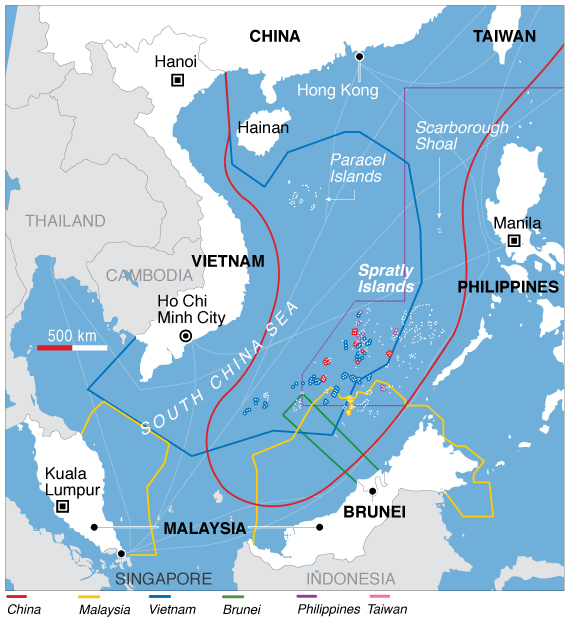Challenging Beijing in the South China Sea
Hanoi and Manila Take Different ApproachesVietnam and the Philippines are both angry at what they see as Chinese bullying in the South China Sea, but Hanoi and Manila are taking different approaches to the standoff over rival maritime claims.
Vietnam is strengthening military ties with the United States, India, Singapore, Japan, Australia, and Russia, building what Joshua Kurlantzick of the U.S. Council on Foreign Relations calls a “web of ad hoc bilateral relationships to shore up their security.”
With Vice Admiral Viktor Chirkov in talks to return Russia’s navy to Cam Ranh Bay, Kurlantzick says Hanoi is sending a clear signal to Beijing that it is not alone in the South China Sea.

Philippines
President Benigno Aquino III tells his parliament July 25 that Manila
will stand firm against Chinese territorial claims on the Spratly
Islands in the South China Sea. Photo: AP
Filipino President Benigno Aquino III is trying to catch up, placing an order for more attack helicopters after China opened a new base in the Paracel Islands to patrol waters claimed by both Vietnam and the Philippines.
Now, more powerful countries such as Vietnam are looking to other solutions after China managed to stymie an attempt to address the maritime claims through the Association of Southeast Asian Nations (ASEAN). But weaker nations such as the Philippines are trying to broaden the mediation effort by taking the dispute to the United Nations.
ASEAN or the United Nations
That move has little support in Washington, says Bonnie Glaser, a senior fellow on China studies at the Center for Strategic and International Studies (CSIS). She says the Obama administration is pushing instead for direct code-of-conduct talks between China and ASEAN.
“The United States doesn’t view this as a U.S./China issue,” Glaser says. “Taking it to the U.N. would make it seem like a U.S./China issue because none of the other permanent Security Council members really have any stake in this issue at all.”
“The Philippines is throwing everything at the wall because they are in the weakest position and they want to see what sticks,” Kurlantzick says. “You have senior Philippine national security officials coming repeatedly to the U.S. and asking for certain types of upgrades. You have them sort of trying to maneuver the U.S. into confirming that because of our relationship with them in the past, the South China Sea would come under that” Mutual Defense Treaty.
Though weaker militarily, Kurlantzick says the Philippines has a more open and democratic political system than Vietnam and is less susceptible to public anger over Chinese aggression.
“Certainly President Aquino has taken some strong steps, and he is not going to back down on certain issues. But at the same time, it’s a much more mature political system,” Kurlantzick says. “So I think public pressure works a number of different ways, and the government is less straightjacketed by nationalistic tendencies because its legitimacy can rest on a number of different foundations.”

Demonstrators
march through Hanoi July 22 protesting China’s claims on South China
Sea territory also claimed by Vietnam. Photo: Reuters
“This has certainly become imbued with a sense of, ‘These are our rights.’ It has become a very sensitive issue,” Glaser says. “On the blogosphere all over China, Chinese citizens, netizens, are calling for their government to defend their interests. And I do believe that the Chinese leadership is very wary of being seen as too soft and not protecting Chinese sovereignty and territorial integrity.”
This is especially so as Washington makes its “Asia Pivot” in military strategy, repositioning Marines and aircraft carrier task forces in the Pacific.

China
is pressing huge territorial claims, outlined in red, in the South
China Sea region. The Philippines, Vietnam and others are also making
claims.
Washington’s ‘Asia Pivot’
“Countries are worried about U.S. staying power, about whether or not there will be a counter-weight to China,” Glaser says. “We are trying to say, ‘Yes. We will be there to ensure peace and security in the region.’ It’s problematic because we don’t want to embolden other countries to engage in a confrontation with China.”
To the extent that they do, Glaser says that would be an unintended consequence of the Asia Pivot.
“Perhaps some of the actions taken by the Philippines might not have been taken if this series of events had taken place at a time when the United States was not seeking to refocus on Asia.
“When we are asked by President Aquino to say something more forcefully about how we will defend the Philippines if it is attacked, this puts the U.S. in a very difficult position,” the CSIS regional expert says. “We don’t want to leave the Philippines in a weak position. But at the same time we don’t want to tell the Philippines, ‘We’ve got your back.’”
No comments:
Post a Comment